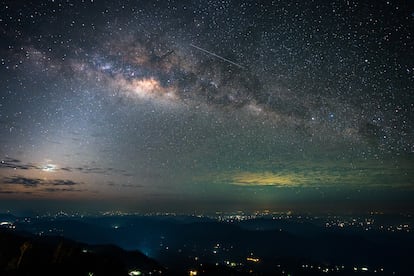Why you have always said your age incorrectly, according to astrophysicists
We are a collection of atoms that have been dancing through the cosmos for billions of years. What is the cosmic age of our bodies? And for that matter, what is Earth’s?

How old are you? It is a simple question that we have all been asked at some point. But the answer is not that simple. In fact, it is surprising if we stop to think about where we come from. The key is to realize that the elements that make up our body are older than we think, even older than our planet.
This is the explanation. It is often said that we are stardust, which is very nice, and we’ve surely heard it before, but it is not strictly true. If we ask ourselves how old our bodies are, we must analyze what a human body actually is.
Well, for the most part, our bodies are composed of water (around 60% by mass). That is H₂O: two atoms of hydrogen for each one of oxygen, which means that most of the approximately 7 octillion atoms that make up our body are hydrogen, or about 62% by number.
And how old are those hydrogen atoms? Again, the answer is not simple. Hydrogen atoms are made up of one proton and one electron. And protons appeared in the universe, according to our most recent calculations, a little less than 13.813 billion years ago, with a margin of error of 38 million years, give or take.
Specifically, the protons of virtually all hydrogen atoms that exist today appeared from the first second after the Big Bang and in the first three minutes counted from that moment, 13.813 billion years ago. From the first second of our universe, quarks, which previously dominated the entire cosmos, disappeared and formed protons and neutrons. Also at that far distant time, the electrons were already quite old. They were formed between a millionth and a trillionth of a second after the Big Bang.
But electrons and protons didn’t come together to form hydrogen until about 380,000 years after the Big Bang. So 62% of the atoms in my body and yours (which constitute 8% of its mass) are a whopping three times older than the formation of our planet, meaning the moment at which our home planet was created. And this leads us to say that we are not stardust, as is often said. Rather, our atoms were conceived, for the most part, shortly after the Big Bang.
Returning to our composition in terms of molecules and their atoms, we had left oxygen hanging. Furthermore, this is a very important element because although hydrogen is the most abundant atom in our body, if we look at the mass, oxygen dominates. It is about 16 times heavier than the single proton and electron that make up hydrogen. And 65% of our mass is oxygen.
And how old is that oxygen that accounts for most of what we see on the scale? There are astrophysicists who have been wondering about this for decades and searching for oxygen, which in truth is easy to find in the universe, in more and more distant galaxies. Oxygen is known to have existed when the universe was less than 3% of its current age. Observing distant galaxies means looking back in time, since they are so far away that it takes almost an eternity for light to reach us. And that delay allows us to “travel” in space-time.
Our studies tell us that three-quarters of the oxygen that exists in the universe today was formed in the first half of the history of the cosmos. The other quarter came later. Further in space, and earlier in time, 50% of the oxygen that exists today was formed in the first quarter of the history of the universe — in the first 3.5 billion years after the Big Bang, when there were still about five billion years to go before the Sun and Earth appeared, which in turn are another 4.5 billion years old. We do have much more data on the formation of oxygen, and we conclude that, on average, our oxygen may be about 10.5 billion years old. So, we’re as old as that.
We are oxygen, carbon, and hydrogen
If we keep asking ourselves how old we are by counting when the elements that make us up were formed, we must go to the next type of atom that contributes to our mass. That element is carbon, which accounts for almost 20% of our mass. Carbon, plus oxygen, plus hydrogen add up to 93% of our body mass. Carbon is somewhat more difficult to observe, but with a radio telescope we can go almost as far and as early in the history of the universe as we can with oxygen.
Up to this point it is enough for us, more or less, to calculate the real age of our bodies. We’ll leave the formation of the other elements (nitrogen, calcium, and phosphorus) for another time. Nor will we stop at the fact that any atom, in reality, comes from that primordial hydrogen that appeared in the first second of our universe, mixed in stellar pots, with the help of other very ancient particles such as photons (that were not always there, they also have a formation epoch).
Pablo G. Pérez González is a researcher at the Spanish Astrobiology Center
Sign up for our weekly newsletter to get more English-language news coverage from EL PAÍS USA Edition
Tu suscripción se está usando en otro dispositivo
¿Quieres añadir otro usuario a tu suscripción?
Si continúas leyendo en este dispositivo, no se podrá leer en el otro.
FlechaTu suscripción se está usando en otro dispositivo y solo puedes acceder a EL PAÍS desde un dispositivo a la vez.
Si quieres compartir tu cuenta, cambia tu suscripción a la modalidad Premium, así podrás añadir otro usuario. Cada uno accederá con su propia cuenta de email, lo que os permitirá personalizar vuestra experiencia en EL PAÍS.
¿Tienes una suscripción de empresa? Accede aquí para contratar más cuentas.
En el caso de no saber quién está usando tu cuenta, te recomendamos cambiar tu contraseña aquí.
Si decides continuar compartiendo tu cuenta, este mensaje se mostrará en tu dispositivo y en el de la otra persona que está usando tu cuenta de forma indefinida, afectando a tu experiencia de lectura. Puedes consultar aquí los términos y condiciones de la suscripción digital.
More information
Archived In
Últimas noticias
Daytime, headphones, no booze involved: How a generation is saying ‘no’ to club parties
Millennia-old Yuracaré language resists extinction through 900 speakers and a new dictionary
Susan Boyle prepares a comeback just as Timothée Chalamet sings her praises
Trump suspends green card visa lottery after shooting at Brown University
Most viewed
- Christian Louboutin: ‘Young people don’t want to be like their parents. And if their parents wear sneakers, they’re going to look for something else’
- US sanctions against jailed cartel leader ‘El Marro’ highlight Mexico’s lack of control over its prisons
- Cartels in Mexico take a leap forward with narco-drones: ‘It is criminal groups that are leading the innovation race’
- Liset Menéndez de la Prida, neuroscientist: ‘It’s not normal to constantly seek pleasure; it’s important to be bored, to be calm’
- ‘El Limones’ and the growing union disguise of Mexican organized crime










































